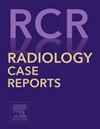气肿性胃炎:诊断的挑战和不同的结果
Q4 Medicine
引用次数: 0
摘要
肺气肿性胃炎(EG)是一种危及生命的疾病,其特征是胃壁内有气体,通常由感染性气体形成生物引起。由于非特异性临床表现和高死亡率,EG对诊断和治疗提出了重大挑战。诊断成像,特别是计算机断层扫描(CT),在诊断和评估EG的进展方面是有帮助的。我们报告了2例不同结果的EG。第一位患者为82岁男性,患有多种合并症,经保守治疗,给予胃减压、静脉注射抗生素和支持治疗,最终康复。第二例患者为81岁男性,患有胃腺癌,由于脓毒症和疑似胃穿孔而迅速恶化,尽管积极治疗,但仍死亡。这些发现强调了早期诊断和个性化管理策略的重要性。两例患者均及时接受腹部CT扫描,显示胃肺肿和门静脉气体等标志性特征。多种实体具有相似的影像学特征,如内部气体,但其病因和临床意义不同。区分不同的x线表现提供了区分EG和其模拟的关键线索,使及时和适当的干预成为可能。结果的可变性强调了进一步研究以改进这种罕见和严重疾病的诊断和治疗方案的必要性。本文章由计算机程序翻译,如有差异,请以英文原文为准。
Emphysematous gastritis: The diagnostic challenges and variable outcomes
Emphysematous gastritis (EG) is a life-threatening condition characterized by gas within the gastric wall, typically caused by infectious gas-forming organisms. With nonspecific clinical presentations and a high mortality rate, EG poses significant diagnostic and therapeutic challenges. Diagnostic imaging, especially computed tomography (CT), is instrumental in diagnosing and evaluating progression of EG. We present 2 cases of EG with differing outcomes. The first patient, an 82-year-old male with multiple comorbidities, was managed conservatively with gastric decompression, intravenous antibiotics, and supportive care, leading to recovery. The second patient, an 81-year-old male with gastric adenocarcinoma, rapidly deteriorated due to sepsis and suspected gastric perforation, succumbing despite aggressive treatment. These findings emphasize the importance of early diagnosis and individualized management strategies. Both patients received prompt abdominal CT scans revealing hallmark features such as gastric pneumatosis and portal venous gas. Multiple entities share similar radiographic features such as intramural gas but differ in their etiology and clinical significance. Distinguishing between different radiographic findings provides critical clues for differentiating EG from its mimics, enabling timely and appropriate intervention. The variability in outcomes underscores the need for further research to improve diagnostic and treatment protocols for this rare and severe condition.
求助全文
通过发布文献求助,成功后即可免费获取论文全文。
去求助
来源期刊

Radiology Case Reports
Medicine-Radiology, Nuclear Medicine and Imaging
CiteScore
1.10
自引率
0.00%
发文量
1074
审稿时长
30 days
期刊介绍:
The content of this journal is exclusively case reports that feature diagnostic imaging. Categories in which case reports can be placed include the musculoskeletal system, spine, central nervous system, head and neck, cardiovascular, chest, gastrointestinal, genitourinary, multisystem, pediatric, emergency, women''s imaging, oncologic, normal variants, medical devices, foreign bodies, interventional radiology, nuclear medicine, molecular imaging, ultrasonography, imaging artifacts, forensic, anthropological, and medical-legal. Articles must be well-documented and include a review of the appropriate literature.
 求助内容:
求助内容: 应助结果提醒方式:
应助结果提醒方式:


